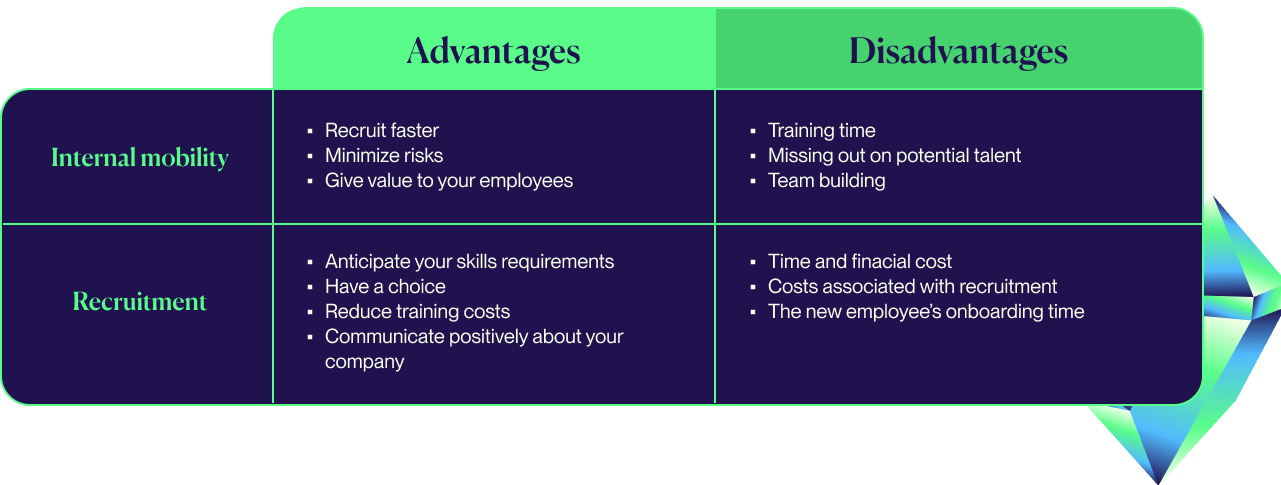Your guide to internal mobility

Is a job open or newly created at your company? Before embarking on the long, tedious and costly process of external recruitment, why not consider looking within? The hidden gem you are looking for may already be right there in your organization! Saving time and money while retaining the talent you’ve invested in and developed — that’s the beauty of internal mobility.
What is internal mobility?
Internal mobility is the movement of talent within an organization, that is to say, the opportunity for an employee to change position or move within their company. Either the employer or the employee can initiate internal mobility and its implementation is the result of a collaborative conversation between the two parties.
There are three types of mobility:
- Lateral: The employee changes roles but keeps their status and hierarchical level.
- Vertical: The employee moves up the hierarchy and into a position with greater responsibilities. This is a promotion.
- Geographical: The employee moves nationally or internationally, this mobility can be combined with the two other mobilities: lateral or vertical.
Internal mobility ≠ change of position
Do you have a one-off, in-house project and do not know which employee would be able to best meet the challenge? Internal mobility is not always synonymous with a change of position. It can also be a way to find the ideal talent in your workforce.
For example, if you need to create an in-house podcast, there may be a person in your workforce who knows all about audio editing. However, this is not necessarily part of their skills identified at the time of recruitment, especially if their job is not connected to this field. But you can still succeed in finding this editing expert, especially if your company uses an Internal Talent Marketplace.
Now let’s dive a little deeper into the differences between internal mobility and external recruitment.
Pros and cons of internal vs. external recruitment
With a precise and up-to-date view of skills, internal mobility is a means of retaining your employees and limiting talent leakage. In return, you will have to ensure that the offer highlighted is attractive, rewarding and comes with clear objectives.
In theory, internal mobility is ideal, since it makes it possible to take advantage of the experience of your talents internally. But in practice, external recruitment often takes precedence and, to be fair, external recruitment does allow you to expand your pool of candidates and can result in a faster recruitment process in terms of required skills, knowledge and experience.
The choice of internal mobility or recruitment should take into account several criteria that make up the recruitment context: the age pyramid, the turnover rate and the corporate culture. An aging pyramid encourages recruitment outside the company, to target talents that are far from retirement age. On the other hand, a high turnover rate can reflect a talent retention and employee satisfaction problem that may be solved with a stronger culture of internal mobility.
In order to make the right choice, it’s up to you, the HR manager, to clearly identify the manager's needs. To streamline the process, you must keep them informed at each stage and your choice to recruit externally or internally must be justified. In this way, you focus on transparency and avoid any potential frustration.
The benefits of internal recruitment
Recruit faster
As an HR manager, you have a cross-company vision of all your employees’ expertise, skills and professional projects. With an Internal Talent Marketplace, you can connect up this information to make attractive offers to your employees.
Minimize risk
In principle, current employees are aligned with your company's values, and this is a huge advantage that can save you a lot of time. Also, you already know their strengths and weaknesses. Mobilizing someone who is already employed in the company allows you to sidestep the adjustment period.
Value your employees
By prioritizing existing employees, you recognize their value and potential. This type of approach strengthens the sense of belonging and motivation. Moreover, employees of companies with dynamic internal mobility policies remain on average twice as long.
The disadvantages of internal recruitment
Training time
Even if your employees are familiar with the company’s values, they do not necessarily have all the skills to perform the job. This is especially the case of internal promotion and when the employee becomes a manager for the first time. To address this, it is important to build training plans to improve your employees’ capabilities.
Missing out on potential talent
Renewal is good! And if your organization struggles to renew itself, onboarding people from different projects is an advantage. When you exclude the possibility of recruiting externally, you can miss out on the right person.
Team politics
You will need to be transparent to avoid discontent and jealousy regarding mobility. Standardize your offers and communicate with managers to remedy this.
An HR assessment tool engages your employee to develop their potential and understand their interests, ambitions and skills better through soft skill assessments including behavioral, cognitive and personality tests. Integrating with a talent experience solution like 365Talents connects and incorporates this professional assessment data into their skills data set so that all your tools can benefit from these insights.
When you integrate your 365Talents with your LMS, your skills framework is centralized, unified and shared between your solutions to evaluate and understand your employees' soft skills.
For employees, integration provides unique insights and centralizes information on their experience, personality and interests in order to better direct and improve career development.
For managers, integration allows them to better see and understand their teams’ soft skills
For HR, integration helps them find relevant candidates for strategic open roles and improves KPIs on internal mobility and success planning.
Integration fosters a user-friendly and engaging experience for your employees to know themselves better and manage their career development while streamlining a transversal and efficient HR process to use this new information in your talent experience for skills analytics, strategic workforce planning and skills matching for internal mobility.
365Talents integrates with AssessFirst, Prismo and SHL, among other popular assessment solutions.








The benefits of external recruitment
Anticipate your skills requirements
External recruitment may provide new expertise that is currently missing in the company. You are able to take a step back on how the company operates, optimize your performance and anticipate the necessary innovations.
Choice!
Compared to internal recruitment, you have access to more applications; in this way, you increase the chances of finding that rare gem.
Reduce training costs
In almost 100% of cases, the person you intend to recruit has all the skills needed to perform the job. In addition, if you choose an individual from the same business sector as your company, onboarding will be even faster. You don’t have any additional training costs to bear.
Communicate positively about your company
A company that recruits is a company that is growing! This growth marker can convey a reassuring message and strengthen your employer brand.
The disadvantages of external recruitment
Time and the financial cost
External recruitment can quickly become time-consuming. It takes more time in terms of process: you need to post the job offer, sort the applications and follow up.
Costs associated with recruitment
If you don’t have the in-house skills to recruit, you will need to use a recruitment firm.
The new employee’s onboarding time
Onboarding is a decisive step in employee loyalty. In the case of a new recruitment, this adaptation time can be quite long.

As you can see in the table above, no option stands out as the best. As is often the case with comparisons of HR practices, everything depends on your objective! For example, if employee retention is your ultimate goal, prioritizing employees who are already in the company is the best solution.
However, even when hiring outside your organization is the right solution for your needs, a culture of internal mobility can benefit your external recruitment efforts as well.
Why promote a culture of internal mobility
1. A culture of internal mobility attracts talent
There will always be times and open positions where you simply can’t avoid hiring externally, but even then, a demonstrable culture of internal mobility can provide a decisive advantage in making sure you’re attracting the very best new talent to your company.
Employee pay has always been an important factor in employee motivation, but in recent years, a new value has become a key driver for employee satisfaction: development prospects. Jobs without opportunities do not inspire the new generation.
If you are seen to be a company that promotes internal mobility, ambitious talents will know that with you, their work and skills will be valued and taken into account when a position opens.
And then, what better than the prospect of a promotion to remain motivated, even in times of adversity?
It’s also a win-win for employees who would like to try out a new career and are offered a type of job that suits them, without them having to leave the company!
Thanks to internal mobility, not only does your structure become more attractive, but also your turnover rate tends to decrease! And that’s good for promoting your employer brand!
2. A culture of internal mobility shows employees more possibilities
Offering internal mobility is also a way of helping employees reflect about their pathway in the company, enabling them to develop and take on responsibilities.
It’s also an opportunity for them to discover professions that they may not have even considered but which match their skills and appetite. The magic of job matching using artificial intelligence can encourage them towards internal job offers.
With geographical mobility, employees even have the opportunity to change workplace while continuing to perform the same functions in the same company.
3. A culture of internal mobility offers easier onboarding
From a structural point of view, developing an employee internally makes onboarding easier. Indeed, they are already familiar with the corporate culture and, more generally, the working environment. They will therefore be operational and efficient much faster than a newcomer.
And then, by mobilizing an employee already in your organization, you avoid any unpleasant surprises: you already know this person, and you know how to collaborate intelligently with them.
4. A culture on internal mobility is a culture of employee support
In times of crisis, such as the recent health, social and economic crises, a culture of internal mobility can offer support for employees. Your team may be more cautious due to current events or postponing their desire to change companies. Under these conditions, they will tend to seek a change in their professional situation internally rather than try to see if the grass is greener on the other side.
5. A culture of internal mobility saves time and money
And last but not least, a decisive argument: the financial aspect.
It’s no secret that recruitment represents a significant financial cost (and time spent) for the company. You spend time setting up your recruitment processes, sourcing and selecting the rare gem. There are also the possible costs of the services of recruitment firms, the posting of offers on social networks or job boards.
Not to mention the possibility of a failed recruitment that would multiply everything by two or more.
The pool of your internal candidates is admittedly smaller but it is also easier to mobilize. They are easy to contact, and sometimes even make the first move themselves!
The HR Online study also reveals that internal mobility costs 50% less than external recruitment.
In short, creating a culture of internal mobility means:
- attracting retaining talent
- showing employees the world of possibilities
- providing support during times of crisis
- saving time & money
What does internal mobility change for the employee?
Internal mobility, for an employee, means changing jobs or moving within their company. This mobility can be vertical, lateral or geographical.
Any internal mobility means that there is a change, whether it comes with a salary increase, upskilling or a hierarchical progression. Or even all three at the same time!
Internal mobility and salary
For many, promotion goes hand in hand with a pay rise. Since this is a new position, with new responsibilities or skills to master, employees often expect their salary to be revalued.
So why isn’t the pay rise automatic?
In the case of lateral mobility, with an equivalent position and the same status, the hierarchy and the HR department may consider that the increase is not justified. Insofar as the hierarchical level remains the same, it may seem logical that the salary must also remain the same.
And more generally, as the business lines are changing rapidly, the positions are likely to evolve and be upgraded. Missions and job titles can therefore change but this does not imply a salary increase.
Internal mobility and training
Developing an employee within the organization means ensuring that they will develop many new skills.
Job Enhancement
And yes, there is no need to change positions to implement internal mobility! Giving an employee more versatility and offering them new functional or operational roles is a way of developing an employee while showing them that you trust them. And it is also and above all a very good way of upskilling.
These job enhancements may involve training or mentoring, for example. They are usually ad hoc and address specific tasks. If these missions become permanent then the question of changing position is raised.
Role Change
In the event of a change in responsibilities within the same position, the employee is entrusted with more demanding tasks and more responsibilities added to the previous ones.
This solution is an interesting step before offering the employee a real promotion. It makes it possible to test them in new positions and to see if they are capable of taking on another position in the short or long term.
Career Change
Sometimes an employee wants a career change, and this is possible internally. They can then move from the accounting department to the digital communications department without having to resign. Offering them this opportunity means ensuring for the employer that their employee does not leave them, while re-motivating them. And for the employee, it’s a great opportunity to start from scratch by training in a completely new profession, without having to change structures. More than upskilling, it’s a real career move.
This is why it is worth having an effective tool that gives visibility to all your internal mobility offers. Employees who wish to change sectors entirely can specify this in the tool. It will propose offers tailored to their desires and needs. It saves everyone time and avoids the risk of them leaving the company. This long-term approach also reduces the turnover rate.
Internal mobility and employee responsibilities
If we put aside any notion of salary, the development of an employee within the same company can also involve increased responsibility. Whether in their transition from employee to manager or towards managerial positions that they did not have before.
Grade change
The coefficient and classification are essential factors in the employee's development. They are used to define a job, classify the position according to the employee's profile, set a minimum wage for each coefficient, and define references for salary increases.
Offering a grade change to an employee, beyond the price rise, means showing that we want them to progress within the company.
Managerial functions
80% of French employees do not want to become a manager, according to a study conducted by Audencia Business School. However, within companies, management is often one of the developments proposed. An employee may be offered the opportunity to become a leader of their own team, or they may become a manager in a different department.
To make sure you don’t miss out on a desire to become a manager, artificial intelligence tools can be very helpful. Your employees complete their profile to show their desire to progress in the hierarchy. Highlighting their skills, experiences and projects makes it easier to think about and prepare for future mobility. And the opposite is equally true, because where they did not initially intend to become a manager, the mobility suggestions they may receive could encourage them to discuss the possibility. Which is just to say...
Capitalize on HRIS platforms & tools
The aim of these tools is to make your life easier, so make the most of them! In the case of internal mobility, you may:
- Obtain an updated skills repository
- Assess skills effectively
- Identify potential profiles for a new position
- Anticipate the development of key skills
Ready to chart a new course for your people at work? Book a demo today to learn about the tools 365Talents provides for internal mobility.
Uncover more HR insights








